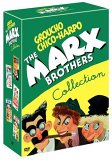Synopsis
This is a fascinating collection, but be warned that this isn’t a “Best Of” by any means. Thereis no Duck Soup here. After leaving Paramount, the Marx Brothers moved to MGM,where (as we learn in the commentaries), studio head Irving Thalberg gave their movies a newform: big, lavish production numbers, and more linear plots.
With the first effort, A Night at the Opera (1935) (****), this approach producedwonders. The formula for all the other films in t…is collection is set here, with Groucho, Chicoand Harpo finally working their chaos to benefit a young couple. In this case, the star-crossedlovers are opera singers. Kitty Carlisle is coveted by the vain lead tenor, even though she’s inlove with Allan Jones. The chaos wreaked at the Metropolitan Opera at the climax is inspiredlunacy.
A Day at the Races (1937) (***1/2) has a virtually identical plot. This time, whatneeds to be saved is a sanitarium run by Maureen O’Sullivan, and the key to the money she needsis a horse owned by Allan Jones (him again) and ridden by Harpo. There are some classicroutines here, but at 109 minutes, the film is too long for what it is.
Two of the discs are double bills (Go West **1/2 and The Big Store ** onone, Room Service ** and At the Circus ** on the other), reflecting the lesserstature of the films included. In fact, these four films are something of a decline and fall.Room Service (1938) is based on a Broadway play that wasn’t written for the Brothers inthe first place, and they did this film on loan to RKO. Here, they’re a struggling theatre troupe.Notable co-stars here are Ann Miller and Lucille Ball. At the Circus (1939) has one ofGroucho’s great songs (“Lydia the Tatooed Lady”) but doesn’t raise many laughs. The westernGo West (1940) has a couple of celebrated scenes – Chico and Harp scamming Grouchofrom his money, and a destructive climax on a train – but these high points are at the beginningand at the end. In The Big Store (1941), our heroes must foil skullduggery at adepartment store. The only really memorable laughs here are unintentional: the big musicalnumber “Tenement Symphony” is atrocious in a very special way.
A Night in Casablanca (1946) (***), the next-to-last Marx Bros. film, is animprovement. Though there is too much plot (concerning Nazi gold stashed in a hotel), there arealso some fine comic moments (notably what amounts to a large-scale throwaway gag involvingHarpo leaning against a building).
Glenn Mitchell’s commentary on A Day at the Races points out a feature of thesefilms that might help contemporary home viewing audiences adjust to the pace of the comedy.There do seem to be long pauses between punchlines, and in a live theatre setting, or in a cinemawith a receptive audiences, this isn’t a problem: the pauses were deliberate, carefully timed toallow the audience time to finish laughing before the next gag. These films were never meant tobe viewed alone at home, so bear this in mind if the timing seems awkward.
Audio
All of the films are in the original mono. Stereo remixes would have been unnecessary andpointless — these are not movies with huge, layered sound design. The mono is generally clean,though the age of the films is evident in some hiss and distortion here and there. The sound iscertainly acceptable, but doesn’t mark any big step up from VHS or TV broadcast.
Video
Depending on the age of the film, there is a greater or lesser degree of grain. Once we hit the1940s, the picture quality is very sharp, with very little grain. The earlier (and better) films aregrainer, though the black-and-white has fine tones and there are no edge enhancement problems.A Night at the Opera has a number of splices, not all of which can be attributed to theheavy handed re-release editing (all references to Italy, according to Leonard Maltin’scommentary, were removed during WWII). The prints are in relatively good shape, but are notcompletely free of damage, and don’t seem to have been restored.
Special Features
The range of extras is in direct proportion to the importance of the film. A Night at theOpera and A Day at the Races are the two discs with commentary (Lenoard maltin onthe former, Marx Brothers Encyclopedia author Glenn Mitchell on the latter). Both tracksare very informative, though Mitchell frequently lapses into silence. Half-hour documentariesaccompany these two films as well. A Night at the Opera has a clip of Groucho on TheHy Gardner Show, reminiscing about Irving Thalberg, while A Day at the Races has anaudio vault. Here you will find the outtake song “A Message from the Man in the Moon” and theradio promo for the film.
The other discs come have a short feature and a cartoon accompanying each film. The twobig titles, which also have these extras, boast Robert Benchley comedy shorts (A Night at theOpera’s short is the Oscar-winning “How to Sleep”). Most of the shorts are comedies, butthere are also a number of cartoons, ranging from Bugs Bunny to the now more obscure Captainand the Kids (these last, in B&W, are on A Day at the Races). All the movies are alsoaccompanied by their theatrical trailers. The menus have scored main screens.
Closing Thoughts
Though the mix of films is uneven, the collection does represent a fairly complete look at thelatter stage of the Brothers’ career. And when the movies are good, they are very goodindeed.
Special Features List
- Audio Commentary on A Night at the Opera
- Audio Commentary on A Day at the Races
- “Remarks on Marx” Documentary
- “On Your Marx, Get Set, Go” Documentary
- Comedy Short Features
- Cartoons
- Theatrical Trailers
- Radio Promos
- Groucho Marx on The Hy Gardner Show
- “A Message from the Man in the Moon” Audio Outtake




